BLOOD VASCULAR SYSTEM
BODY FLUIDS AND CIRCULATION
Functions:-
- Transport of nutrients, O2 , glucose etc.
- Removal of harmful substances
Constituents:-
Blood + Blood vesssels + Heart.
Blood:– Synthesized in Red bone marrow
Medium of transport
_____________________________________
↓ ↓
Water Blood & lymph
Sponges & coelenterates Humans
Components :-
(A) Plasma (matrix, 55%)
Water:- 90-92%
Proteins:- 6-8%
Fibrinogens- clotting, Albumins- Osmotic balance, Globulins- Defense
MInerals:- Na+ , Ca+2 , Mg+2 , HCO-3 , CL –
Nutrients:– Glucose, amino acid , lipids
(B) Formed elements
Parameter RBCs/Erythrocytes WBCs/Leucocytes Platelets/Thrombocytes
Number 5-5.5 million/mm3 6000-8000/mm3 150000-350000/mm3
Colour Red due to iron Colourless Colourlesss
containing Hb
(12-16gm/100 ml)
Nucleus Absent Present Absent
Life span 120 days Generally short lived Short lived
Function Transport of gases Defense Coagulation of blood
if number drops, can lead
to loss of blood from body
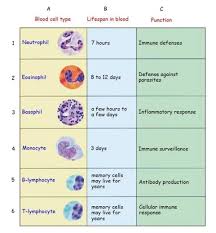
Notes-
- RBC’s are biconcave and enucleated in most mammals.
- platelets are cell fragments of megakaryocytes
- Graveyard of RBCs – spleen
- Basophiles secretes heparin, histamin, serotonin
BLOOD CLOTTING/ COAGULATION
- In response to injury/ trauma, clotting prevents loss of blood from body.
- Events involved
Injured tissue
Platelets
↓
Release chemicals
↓ (Cascade process)
Formation of Thromobokinase
(enzyme complex)
↓ Prothrombin
Thrombin
↓
Firinogens
↓
Fibrins+entangled formed elements
l_______________________________l
(Coagulam/ reddish brown clot)
- Ca+ ions play an important role in clotting
- Clotting factors in blood are in inactive form
BLOOD VESSELS
Layers in wall:-
Name Position Composition
Tunica externa Outermost Fibrous connective tissue & collagen
fibres
Tunica media Middle Smooth muscle & elastic fibres
Tunica intima Innermost Squamous endothelium
- Tunica media
- lumen
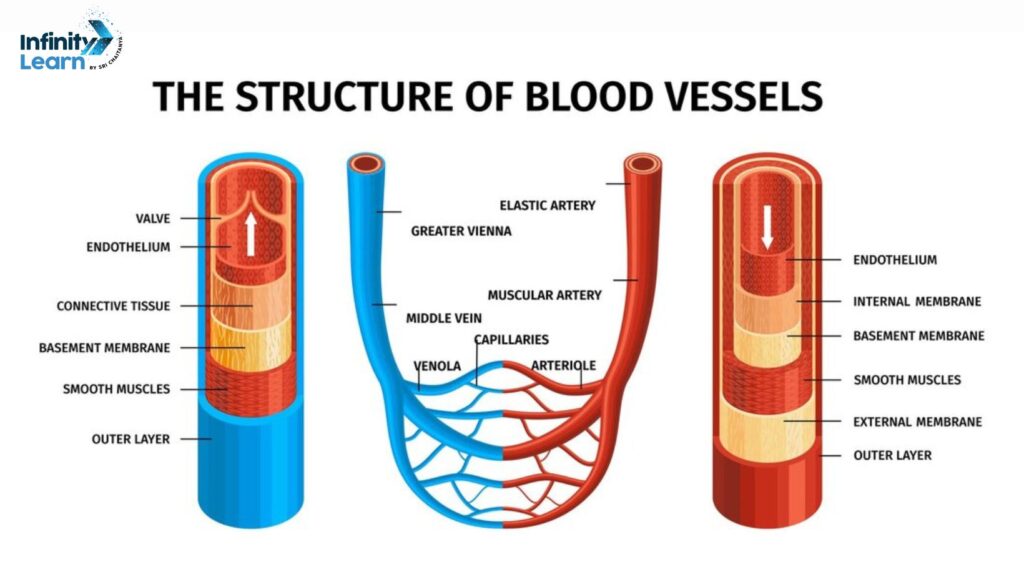
BLOOD GROUP
Based on:-
(i) ABO grouping
_____________________________
↓ ↓
Parameter Natural Antigen Natural Antibodies
Definition Chemicals that induce Proteins produced in
immune response response to antigens
Present On RBC In plasma
Type A,B Anti- A,B
(ii) Rh grouping
__________________
↓ ↓
Parameter Rh+ve Rh-ve
RH factor √ X
Present on RBC X
Note:- 80% humans are Rh +ve.
- Blood group and Rh factor compatibility of donor and recipient is done before transfusion to avoid clumping of RBCs
Blood Antigens Antibodies Donor’s
Group on RBCs in plasma Group
A A anti-B A,O
B B anti-A B,O
AB A,B Nil AB,A,B,O
O Nil anti-A,B O
AB- Universal Donor
O- Universal Recipient.
Note:- Rh-ve person upon exposure to Rh+Ve blood will form Rh specific antibodies.
Special case of Rh Incompatibility
Mother Rh-ve→——————-←Foetus Rh+ve
⇓
- First baby normal, as during pregnancy, no mixing of blood due to separation by placenta. ⇓
- During delivery, there are chances of mixing of blood ⇓
- Rh+ve mother makes antibodies against Rh antigen. ⇓
- Antibodies cross placenta in subsequent pregnancy. ⇓
- Severe anemia and jaundice in baby
⇓ - Erythroblastosis foetails
Note:- Administer anti Rh antibodies to the mother immediately after first delivery, save baby.
CIRCULATORY PATHWAYS
Open Closed
(i) Sinuses Present Absent
(ii) Regulation of Imprecise Precise
blood flow
(iii) Examples Arthropods Annelids,
molluscs chordates
Vertebrates Auricle(s) Ventricle(s) Circulation
Fishes 1 1 Single
Amphibians, 2 1 Incomplete
most reptiles
Crocodile, Aves 2 2 Double
Mammals
Note:- Fishes pump deoxygenated blood to gills for oxygenation.
HUMAN CIRCULATORY SYSTEM
Heart
- Mesodermally derived organ present in between lungs, muscular, chambered, tilted to left.
- Protected by double walled, membranous bag- pericardium with pericardial fluid.
- 4 Chambers:- (i) 2 upper, smaller- Auricles (ii) 2 lower, large- ventricles
- Septum
Between auricles: Inter-atrial (thin, muscular)
Between ventricles: Inter-ventricles (thick walled)
Between auricles & ventricle: Auriculo-ventricular (thick fibrous) - Cardiac valves
Between right auricle & right ventricle- Tricuspid
Between left auricle & left ventricle – Bicuspid/Mitral
At base of pulmonary artery ↓
At base of aorta |↔ both Semilunar
Cardiac muscles
Contractile tissue
Nodal tissue→ Sino-auricular/(SA node/pacemaker)-Right upper Auto excitable corner of right atrium
Atrioventricular node/AV node- Left lower corner of right atrium
AV bundle- Interventricular septum
Purkinje fibres- Divides at apex of ventricle
SAN-Maximum-70-75 action excitability potentials/min.
Note:- Valves are muscular flaps of cusps that allow unidirectional flow of blood and prevent its backward flow.
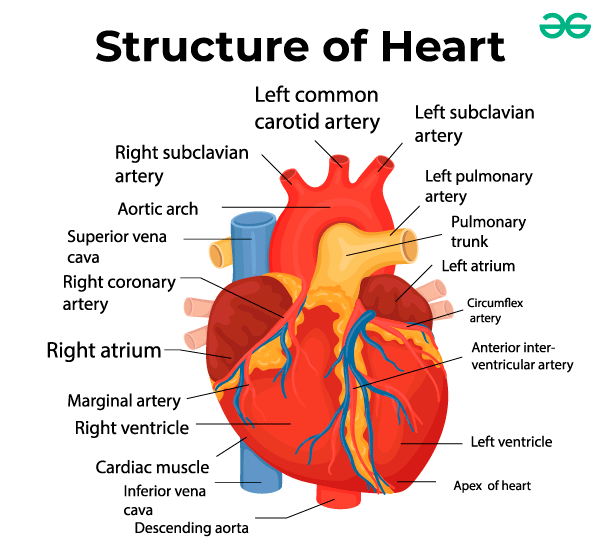
TYPES OF CIRCULATION
- Double circulation→ (i) Pulmonary: Right ventricle→pulmonary No mixing of artery→Lungs→pulmonary veins- Left auricle deoxygenated (ii) Systemic:
and oxygenated
blood occurs Left ventricle→Aorta→Tissues→Vena
cava→Right auricle - Hepatic portal circulation- Digestive track →Hepatic portal vein→Liver
- Coronary circulation- Blood flow to and from the cardiac musculature.
CARDIAC CYCLE
- Sequential events in the heart which are cyclically repeated. Heart beat rate=72 beats/min. Duration of 1 heart beat = 0.8 sec
- Joint diastole
- Atrial systole- SAn generates action potentials
- Ventricular systole- AV node, AV bundles, bundle of his transmit the action potential further.
Events of 1 cardiac cycle
Location/Structure Joint Diastole Atrial Systole Ventricular Systole
Auricle Relax,filling Contract, increase Relax
flow of blood into
ventricles by 30%
Ventricle Relax Relax Contract, throw out
70 ml of blood/
ventricle-
stroke volume
Tri & Bicuspid Open Open Closed, 1st heart valves sound Lub
Semilunar valves Closed 2nd Closed Open
sound Dub
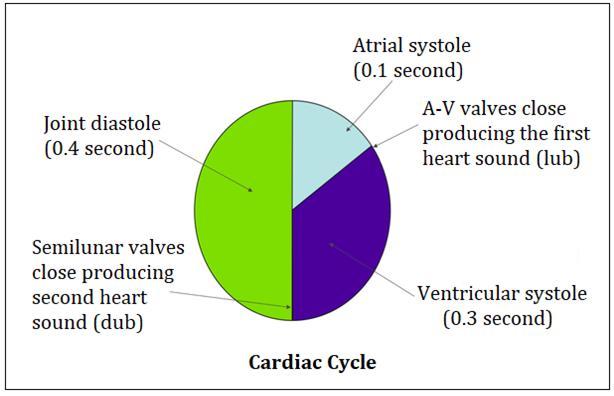
ELECTROCARDIOGRAPH (ECG)
- ECG is a graphical representation of electrical activities of heart during a cardiac cycle.
- Instrument- Electrocardiograph.
- Graphical print- Electrocardiogram.
- For a standard ECG- 3 leads are connected to monitor heart activity- Right wrist and left ankle.
Graphical standards Represent Event associated
P wave Depolarization of atria Contraction of atria
QRS complex Depolarisation of ventricles Contraction of ventricles
T wave Repolarisation of ventricles Relaxation of ventricle
Note:-
(i) Number of QRS complexes in a given time period, determine the heart the beat rate of an individual.
(ii) End of T-wave marks the end of systole.
(iii) Any deviation in ECG indicates a possible abnormally of disease e.g. ECG machine makes sound pip…..pip….pee as patient goes into cardiac arrest.
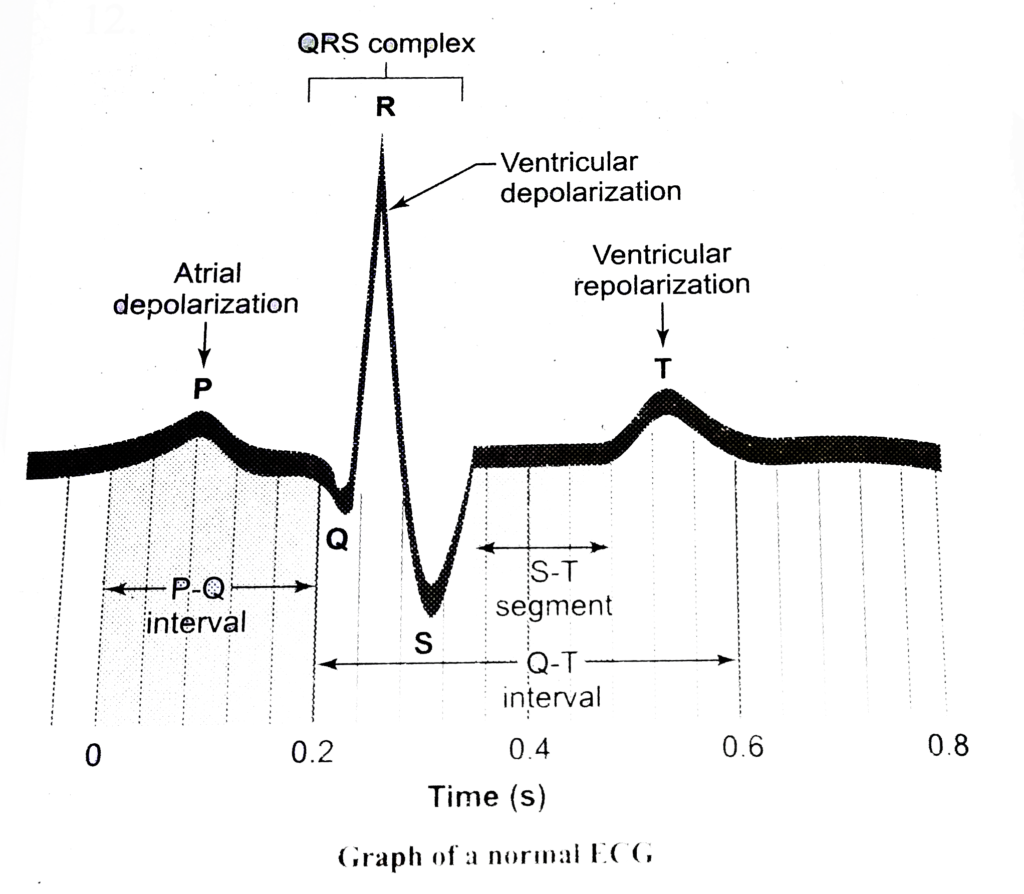
REGULATION OF CARDIAC CYCLE
Activities of heart are regulated intrinsically i.e. autoregulated as human is myogenic
Medulla Oblongata can moderate
↓
Cardiac functions through
Autonomic nervous system (ANS)
|_________________________________|
↓
Parameter Sympathetic Parasympathetic
Heart beat rate Increase Decrease
Strength of ventricular Increase Decrease
contraction
Cardiac output Increase Decrease
Note:- Hormones of adrenal medulla increase cardiac output.
DISORDERS OF CIRCULATORY SYSTEM
Disease Effects
Cardiac arrest- Heart stop beating
Heart failure – Heart is not pumping blood effectively enough to meet needs
of body
Atherosclerosis/ (CAD) – Deposit of Ca+2, fats, cholesterol in blood vessels Coronary artery disease that makes arterial lumen narrower
High blood pressure– Repeated checks of blood pressure heart of an individual = 140/90, leads to heart disease and also affects vital organs like brain and kidneys.
Angina pectoris/- Not enough oxygen is reaching heart muscles. It affects
acute chest pain blood flow. Common in middle aged and elderly.
Heart attack – Heart muscle is suddenly damaged by an inadequate blood supply.
Note:– (i) Heart sound (Lub & dub) can be heard by Stethoscope and have clinical diagnostic significance.
(ii) Cardiac output= Stroke volume X Heart rate= 70 x 70 = 5 liters
(iii) Cardiac output of athletes is higher than a normal man.
- Breathing, also known as respiration, is the process by which organisms take in oxygen from the environment and release carbon dioxide. In humans, breathing involves the movement of air into and out of the lungs.
- Breathing refers to the physical process of inhaling and exhaling air, while respiration refers to the biochemical process by which cells extract energy from nutrients and produce ATP (adenosine triphosphate). Respiration occurs at the cellular level within mitochondria.
- Breathing in humans is facilitated by the respiratory system, which includes the nose, mouth, trachea (windpipe), bronchi, and lungs. During inhalation, the diaphragm and intercostal muscles contract, expanding the chest cavity and drawing air into the lungs. During exhalation, these muscles relax, allowing the lungs to deflate and expel air.
- Oxygen is transported in the blood bound to hemoglobin, a protein found in red blood cells. It can also dissolve in the plasma. Oxygen is delivered to tissues throughout the body via the circulatory system.
- The respiratory system is responsible for exchanging gases (oxygen and carbon dioxide) between the body and the environment. It also helps regulate pH balance, remove waste products, and support vocalization.
- The main respiratory gases are oxygen (O2) and carbon dioxide (CO2). Oxygen is essential for cellular respiration and energy production, while carbon dioxide is a waste product of cellular metabolism.
- Gas exchange is the process by which oxygen and carbon dioxide are exchanged between the bloodstream and body tissues. Oxygen diffuses from the alveoli in the lungs into the bloodstream, while carbon dioxide diffuses from the bloodstream into the alveoli to be exhaled.
- Factors that affect gas exchange in the lungs include the surface area and thickness of the respiratory membrane, the partial pressures of oxygen and carbon dioxide, and the ventilation-perfusion ratio (matching of airflow to blood flow).
- Efficient gas exchange is essential for providing oxygen to cells for cellular respiration, which produces ATP and supports metabolic activities. It also helps remove carbon dioxide, a waste product of metabolism, from the body.
- Respiratory disorders include conditions such as asthma, chronic obstructive pulmonary disease (COPD), pneumonia, bronchitis, and emphysema. These disorders can impair lung function and gas exchange, leading to breathing difficulties and reduced oxygen delivery to tissues.
Heart’s Pumping Power: Did you know that the human heart pumps about 2,000 gallons (or 7,570 liters) of blood through the body every day? That’s equivalent to filling up more than 60 bathtubs!
Blood’s Speedy Travel: Blood doesn’t waste any time getting around! It travels through your body’s blood vessels at an impressive speed of about 3-4 miles (4.8-6.4 kilometers) per hour, even in the tiniest capillaries.
Blood’s Vital Role: Blood is often called the body’s “river of life” for a good reason! Not only does it transport oxygen and nutrients to cells, but it also carries away waste products like carbon dioxide and metabolic byproducts to be removed from the body.
Lymph’s Quiet Journey: While blood gets most of the attention, lymph is equally important! Lymph is a clear fluid that flows through lymphatic vessels, helping to remove toxins, waste, and other unwanted materials from tissues while also playing a crucial role in immune defense.
The Power of Platelets: Platelets are tiny cell fragments in the blood that play a big role in clotting. When you get a cut, platelets rush to the site and stick together to form a plug, helping to stop bleeding and kick-start the healing process.
Blood’s Color: Despite what you might think, blood isn’t always red! Oxygen-rich blood pumped out of the heart is bright red, but once it gives up its oxygen to tissues and picks up carbon dioxide, it turns a darker shade of red.
The Magnificent Heart: The human heart is a powerhouse of muscle! It beats about 100,000 times a day, pumping blood to every cell in the body without ever taking a break. Over a lifetime, it can beat more than 2.5 billion times!
Unique Blood Types: Did you know that not all blood is the same? There are four main blood types: A, B, AB, and O. Each blood type is determined by the presence or absence of certain antigens on the surface of red blood cells.
The Impact of Exercise: Regular exercise is not only good for your muscles but also for your heart! When you exercise, your heart pumps harder and faster, which helps improve circulation, strengthens the heart muscle, and lowers blood pressure.
Circulation in Space: Even astronauts’ bodies need to circulate fluids properly! In space, where gravity is reduced, astronauts’ bodily fluids tend to shift toward their heads, causing their faces to appear puffy and their legs to become thinner. To combat this, astronauts use special exercise equipment and suits to maintain circulation.
4 thoughts on “Body Fluids and Circulation Class 11 Notes”